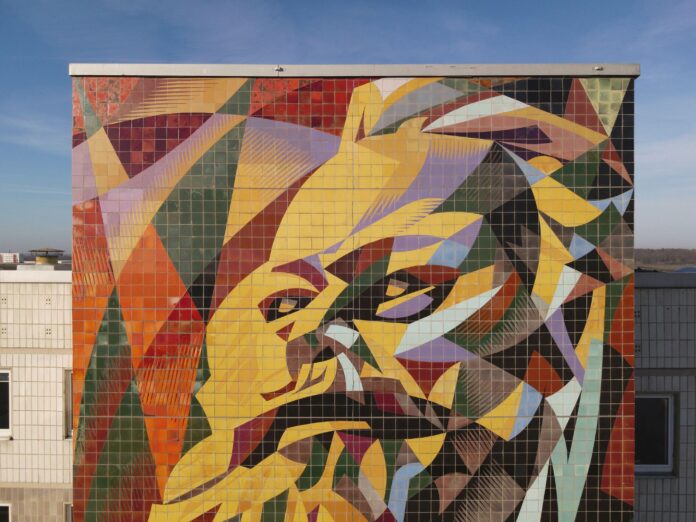A vast mosaic depicting Karl Marx and celebrating the founding of East Germany and the “unity of the working class” was officially handed over to the city of Halle by the private foundation that funded its restoration today.
The mural, by Josep Renau, was completed in 1974 on the external wall of the stairwell of an 11-floor residence for apprentices in Halle-Neustadt, a concrete new town built near the city of Halle during the Cold War to house workers at nearby chemical plants. Since the fall of the Berlin Wall, Halle-Neustadt’s population has dwindled to around 45,000—approximately half its peak in the 1960s.

The mosaic is one of the most important public works of art from communist East Germany
Photo: Thomas Wolf © Wüstenrot Stiftung
The mural, cumbersomely titled The Unity of the Working Classes and Founding of the German Democratic Republic, is 35m high and seven m wide and contains 11,000 tiles. It is considered one of the most important surviving public works of art produced in communist East Germany.
Over the past 30 years, much East German public art has been destroyed, removed during rebuilding projects, or left to decay. It is often dismissed as the remnant of an outdated ideology and deemed unimportant from an art-historical perspective. But recent measures to save such works suggest a shift in such attitudes.

Detail of the mosaic
Photo: Thomas Wolf © Wüstenrot Stiftung
“Even uncomfortable East German cultural heritage shouldn’t just disappear—instead it should be preserved to encourage reflection and debate,” says Philip Kurz, the managing director of the Wüstenrot Foundation, which provided most of the €600,000 restoration funds.
The Wüstenrot Foundation has made preserving East German public art a focus of its heritage protection work. In 2019, the foundation completed the reinstallation of a Renau mosaic composed of 70,000 glass fragments in the city of Erfurt.
Born in Valencia in 1907, Renau was the culture official responsible for overseeing the famous Spanish pavilion at the International Exhibition in Paris in 1937, where Picasso’s Guernica was first shown. Forced to flee Spain after Franco’s victory in the Spanish Civil War, Renau lived in exile in Mexico. There he met important exponents of Mexican muralism, including David Alfaro Siqueiros. He moved to East Germany in 1958.
The restoration process
Photo: Thomas Wolf © Wüstenrot Stiftung
His first mural commission was in Halle-Neustadt. Renau originally proposed an image celebrating the power of nature, but this was overruled by the party, which insisted on a more political theme. The newly restored Marx mosaic was one of two monumental murals by the artist in Halle-Neustadt: the other, The Youth’s March Into the Future, was installed on a nearby canteen and destroyed from 1998 to 1999.
By the time the restoration of Unity of the Working Classes and Founding of the German Democratic Republic began in 2022, many of the tiles had been damaged or come loose due to frost and pollution. The restoration team, led by the Gustav van Treeck studio in Munich, mended tiles where possible and replaced 451 that were too damaged to repair.

























